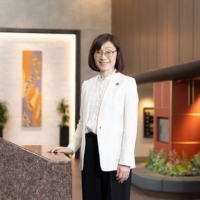Many of Japan's thousands of shotengai (mom-and-pop retailers' districts) are struggling these days as customers desert them for major department stores, discount shops and suburban malls. The Osu district of Nagoya, though, is a notable exception. Bucking the nationwide downturn, this area is popular and thriving, with all manner of shops and restaurants catering to all ages.
Originally a community that grew up some 400 years ago around the Osu Kannon Temple, the area has long flourished as a popular shopping and entertainment district. But in the wake of World War II it started on a steady slope to ruin as larger retailers and entertainment venues opened up in the city's more central Sakae district.
But Osu's traders were not content to simply give up the ghost. For a generation now, they have been working together to add more character to the area and boost shopper traffic. Examples include staging local festivals and encouraging stores specializing in computers and second-hand clothing to open in their midst. New approaches to business and long-held local traditions have blended well, and as a result Osu has regained its former prosperity -- and then some.
Of particular interest for visitors to Nagoya is Osu Kannon's flea market, which is held on the 18th and 28th of every month. Here, stalls are loaded with everything from antique dishes and kimono to tin toys and bric-a-brac, and all at quite modest prices. And just around the corner there's always the option of a stroll around the arcades that make up one of Japan's largest shotengai.
One place there that you'd be hard put to miss is a store called Komehyo that has been in business since 1947 and has lived through a whole host of changes to the town. Calling itself a "super discount recycle department store," Komehyo is a unique shop that markets both quality second-hand goods and brand-new items at bargain prices.
Key to success
As you enter Komehyo's six-floor main building, items such as jewelry, wrist watches, brand bags and clothing, cameras and even musical instruments are neatly displayed at every turn -- and it generally takes a close inspection of the price labels to determine if the goods are new or not.
However, the key to Komehyo's business success is its buying of used goods. The company makes it a strict rule to buy only high-end used items that have warranties. Then, the firm's buyers, who are trained to rigorously check authenticity, condition and the item's market value, offer the seller a price.
"We have stubbornly stuck to second-hand goods, and that has allowed us to distinguish ourselves from others," said Kazutoshi Torita, director of Komehyo's Corporate Planning Department. "Since our foundation, we have always believed that if we pay more money we will be able to offer better things, and that will attract customers if we then market them at a reasonable price," he explained.
In fact, Komehyo has been so successful that last year it was listed on the stock exchanges in Tokyo and Nagoya. Later this year, too, this Osu-born business will be launching a new, seven-story branch in Tokyo's bustling Shinjuku district to complement its existing, smaller outlet in the upmarket Yurakucho area.
All that -- and whatever will come next -- is built on the confidence that this little Nagoya town of Osu gave them. " 'Good things for a good price' is something people anywhere are attracted by," as Torita said.


















With your current subscription plan you can comment on stories. However, before writing your first comment, please create a display name in the Profile section of your subscriber account page.